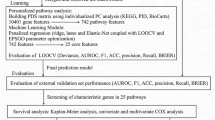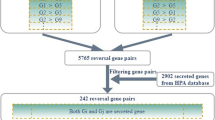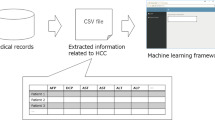Abstract
Hepatocellular carcinoma (HCC) is a leading cause of cancer-related death worldwide. The early diagnosis of HCC is greatly helpful to achieve long-term disease-free survival. However, HCC is usually difficult to be diagnosed at an early stage. The aim of this study was to create the prediction model to diagnose HCC based on gene expression programming (GEP). GEP is an evolutionary algorithm and a domain-independent problem-solving technique. Clinical data show that six serum biomarkers, including gamma-glutamyl transferase, C-reaction protein, carcinoembryonic antigen, alpha-fetoprotein, carbohydrate antigen 153, and carbohydrate antigen 199, are related to HCC characteristics. In this study, the prediction of HCC was made based on these six biomarkers (195 HCC patients and 215 non-HCC controls) by setting up optimal joint models with GEP. The GEP model discriminated 353 out of 410 subjects, representing a determination coefficient of 86.28% (283/328) and 85.37% (70/82) for training and test sets, respectively. Compared to the results from the support vector machine, the artificial neural network, and the multilayer perceptron, GEP showed a better outcome. The results suggested that GEP modeling was a promising and excellent tool in diagnosis of hepatocellular carcinoma, and it could be widely used in HCC auxiliary diagnosis.

The process to establish an efficient model for auxiliary diagnosis of hepatocellular carcinoma




Similar content being viewed by others
References
Aleksandrova K, Boeing H, Nothlings U, Jenab M, Fedirko V, Kaaks R, Lukanova A, Trichopoulou A, Trichopoulos D, Boffetta P, Trepo E, Westhpal S, Duarte-Salles T, Stepien M, Overvad K, Tjonneland A, Halkjaer J, Boutron-Ruault MC, Dossus L, Racine A, Lagiou P, Bamia C, Benetou V, Agnoli C, Palli D, Panico S, Tumino R, Vineis P, Bueno-de-Mesquita B, Peeters PH, Gram IT, Lund E, Weiderpass E, Quiros JR, Agudo A, Sanchez MJ, Gavrila D, Barricarte A, Dorronsoro M, Ohlsson B, Lindkvist B, Johansson A, Sund M, Khaw KT, Wareham N, Travis RC, Riboli E, Pischon T (2014) Inflammatory and metabolic biomarkers and risk of liver and biliary tract cancer. Hepatology 60:858–871. https://doi.org/10.1002/hep.27016
Azzawi H, Hou J, Xiang Y, Alanni R (2016) Lung cancer prediction from microarray data by gene expression programming. IET Syst Biol 10:168–178. https://doi.org/10.1049/iet-syb.2015.0082
Balogh J, Victor D 3rd, Asham EH, Burroughs SG, Boktour M, Saharia A, Li X, Ghobrial RM, Monsour HP Jr (2016) Hepatocellular carcinoma: a review. J Hepatocell Carcinoma 3:41–53. https://doi.org/10.2147/JHC.S61146
Bruix J, Sherman M, Llovet JM, Beaugrand M, Lencioni R, Burroughs AK, Christensen E, Pagliaro L, Colombo M, Rodes J, HCC EPoEo (2001) Clinical management of hepatocellular carcinoma. Conclusions of the Barcelona-2000 EASL conference. European Association for the Study of the Liver. J Hepatol 35:421–430
Budhu A, Wang XW (2006) The role of cytokines in hepatocellular carcinoma. J Leukoc Biol 80:1197–1213. https://doi.org/10.1189/jlb.0506297
Carr BI, Pancoska P, Branch RA (2010) Significance of increased serum GGTP levels in HCC patients. Hepato-Gastroenterology 57:869–874
Choi JY, Lee JM, Sirlin CB (2014) CT and MR imaging diagnosis and staging of hepatocellular carcinoma: part I. Development, growth, and spread: key pathologic and imaging aspects. Radiology 272:635–654. https://doi.org/10.1148/radiol.14132361
Cicchetti DV (1992) Neural networks and diagnosis in the clinical laboratory: state of the art. Clin Chem 38:9–10
Colbourn EA, Roskilly SJ, Rowe RC, York P (2011) Modelling formulations using gene expression programming—a comparative analysis with artificial neural networks. Eur J Pharm Sci 44:366–374. https://doi.org/10.1016/j.ejps.2011.08.021
El-Serag HB, Richardson PA, Everhart JE (2001) The role of diabetes in hepatocellular carcinoma: a case-control study among United States veterans. Am J Gastroenterol 96:2462–2467. https://doi.org/10.1111/j.1572-0241.2001.04054.x
European Association For The Study Of The L, European Organisation For R, Treatment Of C (2012) EASL-EORTC clinical practice guidelines: management of hepatocellular carcinoma. J Hepatol 56:908–943. https://doi.org/10.1016/j.jhep.2011.12.001
Ferreira C (2001) Gene expression programming: a new adaptive algorithm for solving problems. Complex Systems 13(2):87–129
Forner A, Llovet JM, Bruix J (2012) Hepatocellular carcinoma. Lancet 379:1245–1255. https://doi.org/10.1016/S0140-6736(11)61347-0
Hann HW, Wan S, Myers RE, Hann RS, Xing J, Chen B, Yang H (2012) Comprehensive analysis of common serum liver enzymes as prospective predictors of hepatocellular carcinoma in HBV patients. PLoS One 7:e47687. https://doi.org/10.1371/journal.pone.0047687
Heckerling PS, Gerber BS, Tape TG, Wigton RS (2003) Entering the black box of neural networks. Methods Inf Med 42:287–296
Kondo Y, Kimura O, Shimosegawa T (2015) Significant biomarkers for the management of hepatocellular carcinoma. Clin J Gastroenterol 8:109–115. https://doi.org/10.1007/s12328-015-0568-9
Kudo M, Matsui O, Izumi N, Iijima H, Kadoya M, Imai Y, Okusaka T, Miyayama S, Tsuchiya K, Ueshima K, Hiraoka A, Ikeda M, Ogasawara S, Yamashita T, Minami T, Yamakado K, Liver Cancer Study Group of J (2014) JSH consensus-based clinical practice guidelines for the management of hepatocellular carcinoma: 2014 update by the liver cancer study group of Japan. Liver Cancer 3:458–468. https://doi.org/10.1159/000343875
Kusy M, Obrzut B, Kluska J (2013) Application of gene expression programming and neural networks to predict adverse events of radical hysterectomy in cervical cancer patients. Med Biol Eng Comput 51:1357–1365. https://doi.org/10.1007/s11517-013-1108-8
Maclin PS, Dempsey J, Brooks J, Rand J (1991) Using neural networks to diagnose cancer. J Med Syst 15:11–19
Marrero JA, Fontana RJ, Fu S, Conjeevaram HS, Su GL, Lok AS (2005) Alcohol, tobacco and obesity are synergistic risk factors for hepatocellular carcinoma. J Hepatol 42:218–224. https://doi.org/10.1016/j.jhep.2004.10.005
Marrero JA, Feng Z, Wang Y, Nguyen MH, Befeler AS, Roberts LR, Reddy KR, Harnois D, Llovet JM, Normolle D, Dalhgren J, Chia D, Lok AS, Wagner PD, Srivastava S, Schwartz M (2009) Alpha-fetoprotein, des-gamma carboxyprothrombin, and lectin-bound alpha-fetoprotein in early hepatocellular carcinoma. Gastroenterology 137:110–118. https://doi.org/10.1053/j.gastro.2009.04.005
Masuzaki R, Yoshida H, Tateishi R, Shiina S, Omata M (2008) Hepatocellular carcinoma in viral hepatitis: improving standard therapy. Best Pract Res Clin Gastroenterol 22:1137–1151. https://doi.org/10.1016/j.bpg.2008.11.005
McCarthy JF, Marx KA, Hoffman PE, Gee AG, O'Neil P, Ujwal ML, Hotchkiss J (2004) Applications of machine learning and high-dimensional visualization in cancer detection, diagnosis, and management. Ann N Y Acad Sci 1020:239–262. https://doi.org/10.1196/annals.1310.020
Minami Y, Kudo M (2013) Therapeutic response assessment of transcatheter arterial chemoembolization for hepatocellular carcinoma: ultrasonography, CT and MR imaging. Oncology 84(Suppl 1):58–63. https://doi.org/10.1159/000345891
Nakanishi H, Kurosaki M, Tsuchiya K, Yasui Y, Higuchi M, Yoshida T, Komiyama Y, Takaura K, Hayashi T, Kuwabara K, Nakakuki N, Takada H, Ueda M, Tamaki N, Suzuki S, Itakura J, Takahashi Y, Izumi N (2016) Novel pretreatment scoring incorporating C-reactive protein to predict overall survival in advanced hepatocellular carcinoma with sorafenib treatment. Liver Cancer 5:257–268. https://doi.org/10.1159/000449337
Reichl P, Mikulits W (2016) Accuracy of novel diagnostic biomarkers for hepatocellular carcinoma: an update for clinicians (review). Oncol Rep 36:613–625. https://doi.org/10.3892/or.2016.4842
Rich N, Singal AG (2014) Hepatocellular carcinoma tumour markers: current role and expectations. Best Pract Res Clin Gastroenterol 28:843–853. https://doi.org/10.1016/j.bpg.2014.07.018
Singhal A, Jayaraman M, Dhanasekaran DN, Kohli V (2012) Molecular and serum markers in hepatocellular carcinoma: predictive tools for prognosis and recurrence. Crit Rev Oncol Hematol 82:116–140. https://doi.org/10.1016/j.critrevonc.2011.05.005
Tejeda-Maldonado J, Garcia-Juarez I, Aguirre-Valadez J, Gonzalez-Aguirre A, Vilatoba-Chapa M, Armengol-Alonso A, Escobar-Penagos F, Torre A, Sanchez-Avila JF, Carrillo-Perez DL (2015) Diagnosis and treatment of hepatocellular carcinoma: an update. World J Hepatol 7:362–376. https://doi.org/10.4254/wjh.v7.i3.362
Thorgeirsson SS, Grisham JW (2002) Molecular pathogenesis of human hepatocellular carcinoma. Nat Genet 31:339–346. https://doi.org/10.1038/ng0802-339
Tremosini S, Reig M, de Lope CR, Forner A, Bruix J (2010) Treatment of early hepatocellular carcinoma: towards personalized therapy. Dig Liver Dis 42(Suppl 3):S242–S248. https://doi.org/10.1016/S1590-8658(10)60512-9
Wang HY, Hsieh CH, Wen CN, Wen YH, Chen CH, Lu JJ (2016) Cancers screening in an asymptomatic population by using multiple tumour markers. PLoS One 11:e0158285. https://doi.org/10.1371/journal.pone.0158285
Yu Z, Lu H, Si H, Liu S, Li X, Gao C, Cui L, Li C, Yang X, Yao X (2015) A highly efficient gene expression programming (GEP) model for auxiliary diagnosis of small cell lung cancer. PLoS One 10:e0125517. https://doi.org/10.1371/journal.pone.0125517
Funding
This work was funded by Bengbu Medical College (Grant No. BYKY1677).
Author information
Authors and Affiliations
Corresponding author
Ethics declarations
Conflict of interest
The authors declare that they have no competing interests.
Informed consent
Informed consent was obtained from all individual participants included in the study.
Ethical approval
All procedures performed in studies involving human participants were in accordance with the ethical standards of the institutional and/or national research committee and with the 1964 Helsinki declaration and its later amendments or comparable ethical standards.
Rights and permissions
About this article
Cite this article
Zhang, L., Chen, J., Gao, C. et al. An efficient model for auxiliary diagnosis of hepatocellular carcinoma based on gene expression programming. Med Biol Eng Comput 56, 1771–1779 (2018). https://doi.org/10.1007/s11517-018-1811-6
Received:
Accepted:
Published:
Issue Date:
DOI: https://doi.org/10.1007/s11517-018-1811-6




